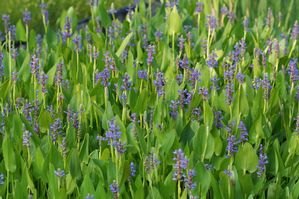Pontederia cordata
Pickerelweed
More About Pickerelweed
Pontederia cordata, Pickerelweed, is a common sight in quiet fresh water areas. Shallow water is the habitat for this beautiful species. The native forms are usually shades of blue-purple, but we also have the uncommon white form. Pontederia cordata flowers from summer to fall, with the flower stalks reaching to about 2 feet above the water. The smooth green leaves look almost tropical. Pickerelweed provides food and shelter for many animals. Nectar feeding insects visit the flowers and fish lurk in the shade of the foliage. Small fish find protection in the thicker areas of Pickerelweed while larger predatory fish, like Bass and Pickerel hide in the more open edges, waiting to ambush prey. The seeds have been eaten and the young shoots cooked as greens. Pickerelweed is excellent for absorbing nutrients from water and improving water clarity. For maximum nutrient removal, the top growth can be cut off and removed (composted) before the plants die back in the fall. This is a common species for bio-purification systems.
Bloom Color
BluePontederia cordata Characteristics & Attributes
|
Exposure
|
Mature Height
|
Spread Characteristics
|
Season of Interest (Flowering)
|
||||||||||||||||||||||||||||||||||||||||||||||||||||||
|
Season of Interest (Foliage)
|
Pond Zonation
|
Foliage Color
|
Wildlife Benefits
|
||||||||||||||||||||||||||||||||||||||||||||||||||||||
|
Wetland Indicator Status
|
Plant Type
|
Attributes
|
USDA Hardiness Zone
|
||||||||||||||||||||||||||||||||||||||||||||||||||||||

